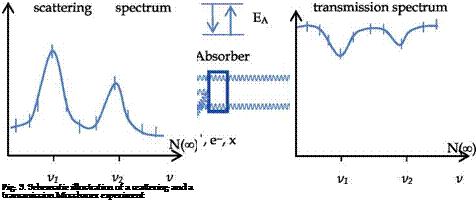1.3 Theoretical aspects
In fig. 3. is shown a block diagram of Mossbauer-transmission and scattering experiments. Doppler shifted y radiation is emitted from a source moving with a velocity v. A certain fraction of this radiation is absorbed resonantly in an absorber. The transmitted radiation is detected in a y detector. The resonance absorption probability and thus the count rate in the detector depend on the relative velocity between the source and the absorber (Weyer 1981). By measuring the count rate at different velocities we can record a transmission spectrum.
 |
For ideal source and absorber materials the lines in the transmission spectrum have approximately Lorentzian shapes for not too thick absorbers (Weyer 1981).
Mossbauer absorption spectroscopy or nuclear y-Resonance method (NGR) in its most common form applies only to materials that contain resonance Mossbauer nucleus (such as Fe, Sn, Co) in the samples that we investigate, and this limits the usage field of the method. The problem concerning the study of physical and chemical attributes and processes in the CM and condensed matter is resolved with the method according to which the Rayleigh Scattering of Mossbauer Radiation (RSMR) is registered and in which Mossbauer radiation interacts with electrons of matter (Zolotoyabko and Iolin 1986; Mossop, Kerr et al. 1987).


